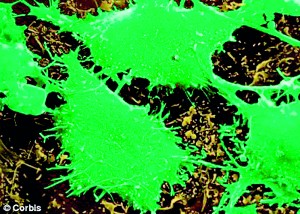Sunday Times 2
The body can destroy cancerous tumours itself
View(s):U.S. researchers have identified a molecule, known as TIC10, which activates protein that helps fight the disease
By Anna Hodgekiss
Scientists have made a key breakthrough in discovering how the body can destroy cancerous tumours itself.

A key benefit of using TRAIL is that it uses the immune system, so it is not toxic to the body like chemotherapy or radiotherapy (pictured)
Researchers from Pennsylvania State University have identified a molecule, known as TIC10, which activates a protein that helps fight the disease.
The protein, called TRAIL, suppresses tumour development during immune surveillance, the immune system’s process of patrolling the body for cancer cells.
This process is lost during cancer progression, which leads to uncontrolled growth and spread of tumours.
The key benefit of using TRAIL (tumour-necrosis-factor-related apoptosis-inducing ligand) as a way to fight cancer is that it is already part of the immune system so it is not toxic to the body like chemotherapy or radiotherapy.
Furthermore, the small size of TIC10 also makes it more effective than past discoveries because it can cross the blood-brain barrier, which separates the main circulatory system from the brain.
This barrier can prevent cancer treatments from entering the brain, thereby hindering the action of drugs for brain tumours.
‘We didn’t actually anticipate that this molecule would be able to treat brain tumours – that was a pleasant surprise,’ said lead researcher Wafik El-Deiry, an oncologist at Pennsylvania State University.
Another positive is that TIC10 does not just activate the TRAIL gene in cancerous cells, but also in healthy ones. This is known as the ‘bystander effect’ – i.e. where cells near cancerous cells are also killed.

The small size of TIC10 also means it can cross the blood-brain barrier, which many anti-cancer drugs cannot do, making it effective at targeting brain cancer cells (pictured)
Nearby healthy cells are also given a boost to increase the number of cancer-killing TRAIL receptors on their cell surface.
Although the study was limited to mice, Dr El-Deiry is confident that a similar approach would work in humans.
He added: ‘I was surprised and impressed that we were able to do this.
‘Using a small molecule to significantly boost and overcome limitations of the TRAIL pathway appears to be a promising way to address difficult to treat cancers using a safe mechanism already used in those with a normal effective immune system.
‘The TRAIL pathway is a powerful way to suppress tumors but current approaches have limitations that we have been trying to overcome to unleash an effective and selective cancer therapy,’ he added.
The success of TRAIL to trigger cancer cell death has led to ongoing clinical trials with artificially created versions, and early trials have shown that giving the protein in drug form is safe.
The study is published in the journal Science Translational Medicine.
© Daily Mail, London
Follow @timesonlinelk
comments powered by Disqus


















